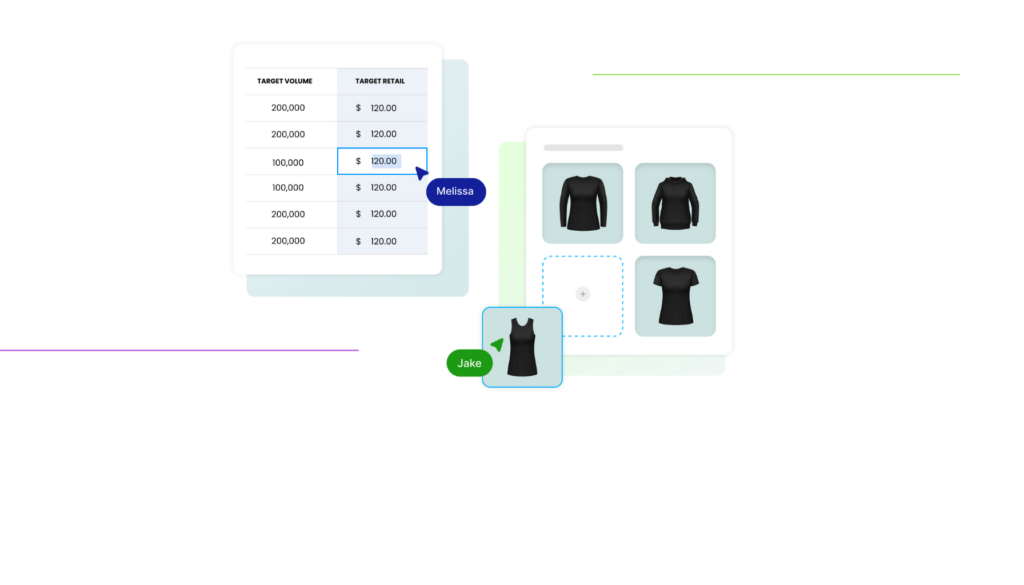When it comes to product development, especially in the retail, fashion, and apparel sectors, brands often face a critical question: Do you truly understand your product line?
At first glance, this seems like a simple question, but in reality, the answer is often elusive. Brands are product companies—their product line is at the heart of their business. However, many brands struggle to get a real-time, clear picture of their product line as it comes to life. This challenge largely stems from inefficient, disconnected tools and workflows that leave teams working in silos during the critical early stages of the go-to-market process. Without full visibility into the product line, it’s nearly impossible to make well-informed decisions before it’s too late.
The result? Missed opportunities, costly late-stage changes, and ultimately, a negative impact on revenue and profit margins. In this piece, we’ll explore why retail and apparel brands should rethink their product development processes and how digital tools can solve these challenges.
The Problem: Fragmented Tools and Missed Opportunities
For most brands, product development is managed through a patchwork of tools—spreadsheets, slide decks, digital whiteboards—each serving different teams and purposes. While these tools are familiar, they are disconnected from each other and from the actual product data, leaving teams working with incomplete and inaccurate information as they build their product line.
Imagine this: your design team is creating mood boards on a whiteboard, your merchandising team is analyzing margins in spreadsheets, and your product team is forecasting sales using slide decks. Each team is working with pieces of the puzzle, but no one has the full picture. This is the reality for many brands, and it creates significant inefficiencies.
Without a unified source of data, you can’t fully understand your product line. You don’t know if the right products are being developed or if the numbers align with the creative vision. And because this information isn’t consolidated, it often leads to last-minute changes—changes that are costly and disruptive.
The Business Impact
Every late-stage adjustment to your product line reduces margins, creates inefficiencies in inventory management, and puts pressure on your supply chain. The cost of making changes increases exponentially as you progress through the go-to-market process. The earlier you can optimize your product line, the greater the business impact.
The Business Value of Understanding Your Product Line
The key to avoiding costly inefficiencies is gaining full visibility and understanding of your product line—not just earlier in the process but throughout the planning, design, and iteration stages. The ability to see and understand your entire product line as it comes to life allows brands to be more agile and create products better aligned with market trends and consumer demand. This reduces sampling costs and ultimately improves margins.
When teams have real-time insight into the product line early in the development process, they can identify potential issues and make necessary adjustments before significant investments are made. For example, a brand that understands its product line early can drop underperforming products before they reach costly sampling or production stages, saving both time and money.
Reduced Sampling Costs and Improved Margins
Reduced Sampling Costs: By gaining full visibility into your product line earlier in the process, you reduce the need for excessive sampling. With a comprehensive view of the product line, brands can confidently remove unnecessary SKUs, resulting in fewer samples and a more focused, cost-effective development process.
Capitalizing on Market Trends and Filling Gaps: Conversely, understanding your product line earlier provides teams with an opportunity to proactively respond to market trends or fill gaps in your product offering. When brands can see what’s missing or spot emerging trends, they can add products earlier in the process rather than scrambling to introduce late-stage additions. Late adds come with high costs, including increased transportation expenses for rush shipping, additional sampling costs, and disrupted production schedules. By making these adjustments earlier, brands avoid the steep costs associated with last-minute changes and ensure their product line remains competitive and responsive to consumer demand.
Improved Margins: Avoiding late-stage changes helps protect margins. Early-stage visibility ensures that the right products are being developed from the start, reducing the risk of overproduction, markdowns, and other costly mistakes. When teams can make adjustments earlier, they avoid the last-minute rush to modify product lines, which often leads to rushed production timelines and higher costs.
Digital Product Workspace: The Solution to Fragmented Product Development
To overcome these challenges, brands need to adopt a new way of working—one that provides real-time, accurate, and fully attributed product data that all teams can access and collaborate on. This is where a Digital Product Workspace comes in.
A Single Source of Truth: A Digital Product Workspace offers a single platform where teams can collaborate in real time, ensuring everyone—from merchandising and design to product and sales—has access to the same, up-to-date information. These platforms combine both qualitative aspects (e.g., design, materials) and quantitative data (e.g., pricing, margins) into one view, providing a comprehensive understanding of the product line from the earliest stages.
Instead of trying to piece together insights from disconnected tools, a Digital Product Workspace brings everything together. Teams no longer have to wonder if they’re working with the most current product data—they can confidently make decisions knowing everyone is working from the same source of truth.
Improved Collaboration and Efficiency: By breaking down silos, digital product workspaces allow teams to collaborate more effectively. With real-time access to product data, teams can make informed decisions faster, reducing delays and the risk of costly last-minute changes. This leads to a more agile and efficient product development process, where all teams are aligned and working toward the same goals.
Roadmap to Solving These Challenges: Brian Lindauer’s Session at PI Apparel NY
At PI Apparel Merchandise Planning NY, VibeIQ’s CEO, Brian Lindauer, will address these challenges in his thought leadership session titled “Digital Product Workspaces: Improving Market Performance by Changing How Your Teams Collaborate.”
In his presentation, Brian will explore the struggles that retail, fashion, and apparel brands face when managing their product development processes with disconnected tools. He’ll explain how a Digital Product Workspace provides a solution by offering real-time, fully attributed data that helps teams make better decisions earlier in the go-to-market process.
Do You Understand Your Product Line?
If your brand still relies on fragmented tools like spreadsheets and slide decks, the answer is likely no. Without real-time, accurate, and attributed product data, it’s impossible to fully understand your product line as it’s being developed. And when you don’t understand your product line, you’re at risk of making costly mistakes that hurt your margins and slow down your time to market.
By rethinking your product development processes and adopting a Digital Product Workspace, your teams can collaborate more efficiently, make better decisions earlier, and bring better products to market faster.
Stop by our booth at PI Apparel Merchandise Planning NY and learn how VibeIQ’s Digital Product Workspace can help you gain control over your product line and drive better business results.
Ready to talk to our team now? Get in touch for an early look at how VibeIQ can help transform your GTM process.



